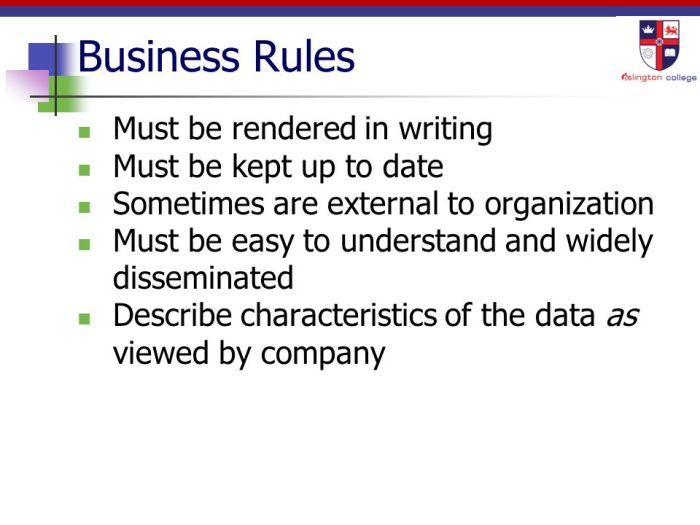Business rules must be rendered in writing to ensure effective decision-making, enhance communication, maintain consistency, and facilitate compliance. This comprehensive guide explores the significance of written business rules, various methods for documenting them, best practices for their creation, and the tools and technologies that support their management.
Real-world examples and a case study demonstrate the practical applications and benefits of implementing written business rules in diverse industries.
1. Business Rules Definition
Business rules are the explicit and well-defined statements that dictate how an organization conducts its operations and makes decisions. They provide a framework for consistent decision-making, ensuring that business processes are executed in a manner that aligns with the organization’s goals and objectives.
Clearly defining business rules is essential for effective decision-making as it eliminates ambiguity, ensures transparency, and promotes accountability. Well-defined business rules enable organizations to streamline their operations, reduce errors, and improve compliance with regulatory and legal requirements.
2. Importance of Written Business Rules

Rendering business rules in writing offers several advantages:
- Improved Communication:Written business rules serve as a central repository of information, facilitating clear and consistent communication among stakeholders.
- Consistency:Written rules help maintain consistency in decision-making across the organization, reducing the risk of arbitrary or biased decisions.
- Compliance:Documented business rules provide evidence of compliance with industry regulations and standards, reducing the risk of legal or financial penalties.
3. Methods for Rendering Business Rules in Writing

Various methods can be used to document business rules:
Decision Tables
Decision tables are tabular representations that define the relationship between conditions and actions. They are suitable for complex rules with multiple conditions and outcomes.
Flowcharts, Business rules must be rendered in writing
Flowcharts are graphical representations that depict the sequence of steps involved in a business process. They are useful for visualizing the flow of logic and identifying potential bottlenecks.
Natural Language
Business rules can also be expressed in natural language, using clear and concise statements. This method is straightforward but requires careful attention to detail to avoid ambiguity.
4. Best Practices for Writing Business Rules

When writing business rules, it is essential to follow best practices:
- Clarity:Rules should be written in plain language, avoiding technical jargon and ensuring easy comprehension.
- Conciseness:Rules should be as brief as possible while still conveying the intended meaning.
- Unambiguity:Rules should be precise and specific, leaving no room for interpretation or misunderstanding.
FAQ Summary: Business Rules Must Be Rendered In Writing
Why is it important to render business rules in writing?
Written business rules provide clarity, consistency, and a single source of truth, reducing errors, improving communication, and facilitating compliance.
What are the different methods for documenting business rules?
Common methods include decision tables, flowcharts, natural language, and decision model notation (DMN).
What are the best practices for writing business rules?
Use clear and concise language, avoid technical jargon, ensure consistency in terminology, and involve stakeholders in the review and approval process.